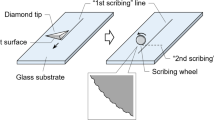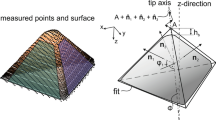Abstract
The interaction between nanosecond laser and glass is complicated, and defects such as micro-cracks and fractures are prone to be generated during laser scribing. Acoustic emission (AE) technique is applied in this paper to monitor laser scribing of float glass. Strong consistency between AE signals and width of laser ablation area is found. With laser power increasing from 11.2 to 26.9 W, root mean square (RMS) values increase from 0.160 to 0.634 V, and width of heat affected zone (HAZ) increase from 12.396 to 53.711 \({\upmu }\text{m}\). Correlation between AE signals and laser scribing quality is investigated by characteristic analysis. When scanning speed is kept constant (200 mm/s) and laser power is gradually increasing from 11.2 to 24.2 W, RMS values and MARSE are increasing (0.3–1.2 V, 600–1500 correspondingly), and scribing quality is declining continuously (\(\frac{{W}_{C}}{{W}_{G}}\) increase from 0 to 0.343). Time-frequency spectrum analysis by CWT could be applied in defects diagnosis. Three prominent frequency bands contents (150 ~ 180 kHz, 200 ~ 250 kHz, and 280 ~ 320 kHz) were generated during laser scribing process. Higher frequency bands contents (200 ~ 250 kHz, and 280 ~ 320 kHz) are demonstrated to reflect defects by analyzing distribution characteristic of frequency contents. Intensity of higher frequency compositions is vigorous (≥ 0.5) when there are defects, while less than 0.5 with no defects.









Similar content being viewed by others
References
Bhuiyan, M. S. H., Choudhury, I. A., Dahari, M., Nukman, Y., & Dawal, S. Z. (2016). Application of acoustic emission sensor to investigate the frequency of tool wear and plastic deformation in tool condition monitoring. Measurement: Journal of the International Measurement Confederation, 92, 208–217. https://doi.org/10.1016/j.measurement.2016.06.006.
Chethan, Y. D., Ravindra, H. V., & Krishnegowda, Y. T. (2019). Optimization of machining parameters in turning Nimonic-75 using machine vision and acoustic emission signals by Taguchi technique. Measurement: Journal of the International Measurement Confederation, 144, 144–154. https://doi.org/10.1016/j.measurement.2019.05.035.
Datsiou, K. C., Spirrett, F., Ashcroft, I., Magallanes, M., Christie, S., & Goodridge, R. (2021). Laser powder bed fusion of soda lime silica glass: Optimisation of processing parameters and evaluation of part properties. Additive Manufacturing, 39, 101880. https://doi.org/10.1016/j.addma.2021.101880
Eschner, N., Weiser, L., Häfner, B., & Lanza, G. (2020). Classification of specimen density in laser powder bed fusion (L-PBF) using in-process structureborne acoustic process emissions. Additive Manufacturing, 34, 101324. https://doi.org/10.1016/j.addma.2020.101324
Ferreira, P. H. D., Fabris, D. C. N., Boas, V., Bezerra, M. O. C., Mendonça, I. G., C. R., & Zanotto, E. D. (2021). Transparent glass-ceramic waveguides made by femtosecond laser writing. Optics and Laser Technology, 136, 106742. https://doi.org/10.1016/j.optlastec.2020.106742
Forte, G., Alberini, F., Simmons, M., & Stitt, H. E. (2021). Use of acoustic emission in combination with machine learning: monitoring of gas–liquid mixing in stirred tanks. Journal of Intelligent Manufacturing, 32(2), 633–647. https://doi.org/10.1007/s10845-020-01611-z
Ghayoomi Mohammadi, M., Mahmoud, D., & Elbestawi, M. (2021). On the application of machine learning for defect detection in L-PBF additive manufacturing. Optics and Laser Technology, 143(April), 107338. https://doi.org/10.1016/j.optlastec.2021.107338
Haas, M., El Syaad, K., Cihak-Bayr, U., Pauschitz, A., & Gröschl, M. (2020). Examination of undisturbed acoustic emission generated by experimentally modelled two-body abrasive wear events. Tribology International, 141, 105912. https://doi.org/10.1016/j.triboint.2019.105912
Haq, M., Bhalla, S., & Naqvi, T. (2020). Fatigue damage monitoring of reinforced concrete frames using wavelet transform energy of PZT-based admittance signals. Measurement: Journal of the International Measurement Confederation, 164, 108033. https://doi.org/10.1016/j.measurement.2020.108033
Hossain, M. S., & Taheri, H. (2020). In Situ Process Monitoring for Additive Manufacturing Through Acoustic Techniques. Journal of Materials Engineering and Performance, 29(10), 6249–6262. https://doi.org/10.1007/s11665-020-05125-w
Huang, Y., Xu, S., Yang, L., Zhao, S., Liu, Y., & Shi, Y. (2019). Defect detection during laser welding using electrical signals and high-speed photography. Journal of Materials Processing Technology, 271, 394–403. https://doi.org/10.1016/j.jmatprotec.2019.04.022
Jiao, J., & Wang, X. (2009). Cutting glass substrates with dual-laser beams. Optics and Lasers in Engineering, 47(7–8), 860–864. https://doi.org/10.1016/j.optlaseng.2008.12.009
Jiao, Y., Brousseau, E., Shen, X., Wang, X., Han, Q., Zhu, H., et al. (2020). Investigations in the fabrication of surface patterns for wettability modification on a Zr-based bulk metallic glass by nanosecond laser surface texturing. Journal of Materials Processing Technology, 283(January), 116714. https://doi.org/10.1016/j.jmatprotec.2020.116714
Kazi, M. K., Eljack, F., & Mahdi, E. (2020). Predictive ANN models for varying filler content for cotton fiber/PVC composites based on experimental load displacement curves. Composite Structures, 254(July), 112885. https://doi.org/10.1016/j.compstruct.2020.112885
König, F., Sous, C., Chaib, O. A., & Jacobs, G. (2021). Machine learning based anomaly detection and classification of acoustic emission events for wear monitoring in sliding bearing systems. Tribology International 155, 106811. https://doi.org/10.1016/j.triboint.2020.106811
Liu, P., Deng, L., Zhang, F., Chen, H., Duan, J., & Zeng, X. (2020). Study on high-efficiency separation of laminated glass by skillfully combining laser-induced thermal-crack propagation and laser thermal melting. Applied Physics A: Materials Science and Processing, 126(4), 1–13. https://doi.org/10.1007/s00339-020-3461-4
Luo, Y., Zhu, L., Han, J., Xie, X., Wan, R., & Zhu, Y. (2019a). Study on the acoustic emission effect of plasma plume in pulsed laser welding. Mechanical Systems and Signal Processing, 124, 715–723. https://doi.org/10.1016/j.ymssp.2019a.01.045
Luo, Y., Zhu, L., Han, J., Xu, J., Zhang, C., & Chen, D. (2019b). Effect of focusing condition on laser energy absorption characteristics in pulsed laser welding. Optics and Laser Technology, 117(April), 52–63. https://doi.org/10.1016/j.optlastec.2019b.04.001
Ma, R., Ji, L., & Yan, T. (2020). Laser multi-focus precision cutting of thick sapphire by spherical aberration rectification. Optics and Lasers in Engineering, 126, 105876. https://doi.org/10.1016/j.optlaseng.2019.105876
Mačernyte, L., Skruibis, J., Vaičaitis, V., Sirutkaitis, R., & Balachninaite, O. (2019). Femtosecond laser micromachining of soda-lime glass in ambient air and under various aqueous solutions. Micromachines, 10(6), 354.https://doi.org/10.3390/mi10060354
Manarikkal, I., Elasha, F., & Mba, D. (2021). Diagnostics and prognostics of planetary gearbox using CWT, auto regression (AR) and K-means algorithm. Applied Acoustics, 184, 108314. https://doi.org/10.1016/j.apacoust.2021.108314
Nisar, S., Li, L., & Sheikh, M. A. (2013). Laser glass cutting techniques—A review. Journal of Laser Applications, 25(4), 042010. https://doi.org/10.2351/1.4807895
Rong, Y., Huang, Y., Li, M., Zhang, G., & Wu, C. (2021). High-quality cutting polarizing film (POL) by 355 nm nanosecond laser ablation. Optics and Laser Technology, 135, 106690. https://doi.org/10.1016/j.optlastec.2020.106690
Shin, H., & Kim, D. (2018). Cutting thin glass by femtosecond laser ablation. Optics and Laser Technology, 102, 1–11. https://doi.org/10.1016/j.optlastec.2017.12.020
Shin, J. (2019). Investigation of the surface morphology in glass scribing with a UV picosecond laser. Optics and Laser Technology, 111, 307–314. https://doi.org/10.1016/j.optlastec.2018.10.008
Wang, H., Guo, L., Zhang, X., Dong, J., Lue, Q., Zhang, Q., et al. (2021). Influence of processing parameters on the quality of titanium-coated glass welded by nanosecond pulse laser. Optics and Laser Technology, 144(378), 107411. https://doi.org/10.1016/j.optlastec.2021.107411
Wu, C., Li, M., Huang, Y., & Rong, Y. (2021). Cutting of polyethylene terephthalate (PET) film by 355 nm nanosecond laser. Optics and Laser Technology, 133, 106565. https://doi.org/10.1016/j.optlastec.2020.106565
Xie, X., Huang, Q., Long, J., Ren, Q., Hu, W., & Liu, S. (2020). A new monitoring method for metal rust removal states in pulsed laser derusting via acoustic emission techniques. Journal of Materials Processing Technology, 275, 116321. https://doi.org/10.1016/j.jmatprotec.2019.116321.
Xie, X., Zhang, Y., Huang, Q., Huang, Y., Zhang, W., Zhang, J., & Long, J. (2020). Monitoring method for femtosecond laser modification of silicon carbide via acoustic emission techniques. Journal of Materials Processing Technology, 290, 116990. https://doi.org/10.1016/j.jmatprotec.2020.116990
Yusof, M. F. M., Ishak, M., & Ghazali, M. F. (2020). Classification of weld penetration condition through synchrosqueezed-wavelet analysis of sound signal acquired from pulse mode laser welding process. Journal of Materials Processing Technology, 279, 116559. https://doi.org/10.1016/j.jmatprotec.2019116559
Zhao, C., Zhang, H., Yang, L., Wang, Y., & Ding, Y. (2016). Dual laser beam revising the separation path technology of laser induced thermal-crack propagation for asymmetric linear cutting glass. International Journal of Machine Tools and Manufacture, 106, 43–55. https://doi.org/10.1016/j.ijmachtools.2016.04.005
Acknowledgements
This work was supported by the National Natural Science Foundation of China (52005206, 51905191), the China Postdoctoral Science Foundation (2020TQ0110), Ministry of Industry and Information Technology’s special project for high-quality development of manufacturing industry (TC200H02H).
Author information
Authors and Affiliations
Corresponding author
Additional information
Publisher’s Note
Springer Nature remains neutral with regard to jurisdictional claims in published maps and institutional affiliations.
Rights and permissions
About this article
Cite this article
Liu, W., Zhang, G., Huang, Y. et al. A novel monitoring method of nanosecond laser scribing float glass with acoustic emission. J Intell Manuf 34, 1721–1729 (2023). https://doi.org/10.1007/s10845-021-01895-9
Received:
Accepted:
Published:
Issue Date:
DOI: https://doi.org/10.1007/s10845-021-01895-9




